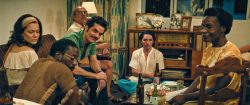Posted February 10, 2015
Image, Sound, and Story in the Classroom
This is a post by Brady Shoemaker, JBFC Director of Curriculum
 “Watch your framing,†I said as I looked over the student’s shoulder at the viewfinder of her camera. “Oh, right; rule of thirds,†she said as she adjusted her shot.
“Watch your framing,†I said as I looked over the student’s shoulder at the viewfinder of her camera. “Oh, right; rule of thirds,†she said as she adjusted her shot.
It was a tough shot to get right–a reflection in a car’s side mirror–but it was the last image they needed to complete the “Five Frame Story†they had been working on all morning. They were determined to get it.
The students that day were eight middle school teachers from five different schools in Rye, Mt. Pleasant, Yonkers, Scarsdale, and Croton-on Hudson, spending a week of their summer learning the JBFC’s new curriculum, Image, Sound, and Story. The teachers are now piloting the 7th and 8th grade strand of the curriculum that guides their students through a series of hands-on projects that emphasize process, challenge-based learning, collaboration, and reflection. The curriculum is structured around ten literacy concepts (Image, Sound, Story, Character, Setting, Structure, Mood, Point of View, Theme, and Style) that fit seamlessly into the teachers’ current ELA curriculum and are aligned with both Common Core Standards and the JBFC Learning Framework.
These days, summer is just a warm memory, but the cohort of eight teachers and I have been reflecting, reviewing, and revising our work together all fall. “Image, Sound and Story†has been developed through the teaching JBFC has done in schools and at the Lab over the past 14 years, but this is the first time we are disseminating our curriculum through the web. Our pilot group from this summer is not only helping to shape the experience of the curriculum in the classroom, but their students are also enjoying an amazing experience.
I recently visited a 7th grade classroom of one of the Image, Sound and Story teachers. The students were beginning to create their own Five Frame Stories. The Project was being shown on a smart board from the JBFC education website, and the students were working on a View Now Do Now as they came in and settled into their seats. We began by viewing an example of a Five Frame Story, reviewing shot types and meanings, and of course, we talked about story arc and structure. Students were actively engaged in the discussion, and were able to immediately apply the objectives to begin communicating their stories through images.
“Remember the Rule of Thirds,†I heard the teacher tell the student she was assisting. “Watch your framing.â€
____
Are you an educator interested in professional development opportunities like this one? Check out our Summer Teachers Institute. Registration for 2015 will open on February 18.
Photo: Adam Weiss


